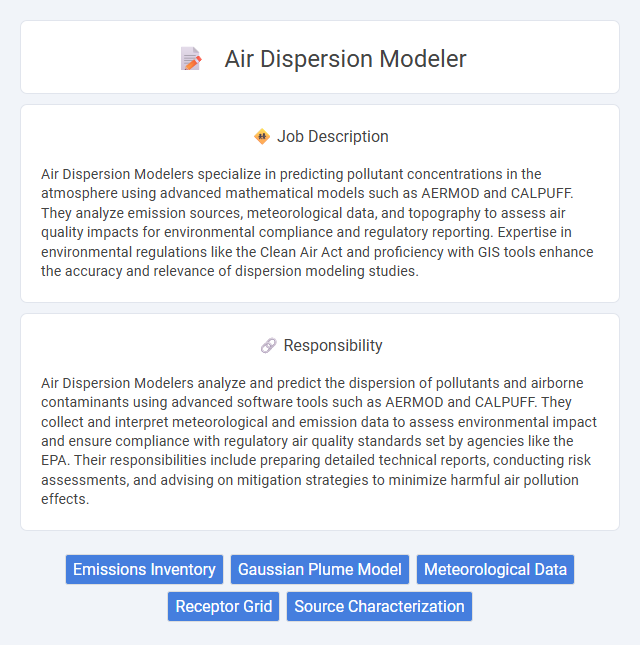
Air Dispersion Modelers specialize in predicting pollutant concentrations in the atmosphere using advanced mathematical models such as AERMOD and CALPUFF. They analyze emission sources, meteorological data, and topography to assess air quality impacts for environmental compliance and regulatory reporting. Expertise in environmental regulations like the Clean Air Act and proficiency with GIS tools enhance the accuracy and relevance of dispersion modeling studies.
Individuals with strong analytical skills and a background in environmental science or engineering are likely suitable for an Air Dispersion Modeler role, as the job demands proficiency in interpreting complex data related to air quality and pollutant dispersion. Those who are detail-oriented and comfortable working with computer modeling software may find this position aligns well with their abilities. However, people who prefer highly social or non-technical roles might find it challenging to adapt to the focused, technical nature of the job.
Qualification
Air Dispersion Modeler positions typically require a strong foundation in atmospheric sciences, environmental engineering, or related fields, often supported by a bachelor's or master's degree. Proficiency in using dispersion modeling software such as AERMOD, CALPUFF, or ISCST3 is essential, along with experience in air quality data analysis and regulatory compliance. Candidates must demonstrate expertise in interpreting meteorological and emissions data to predict pollutant dispersion and assess environmental impact accurately.
Responsibility
Air Dispersion Modelers analyze and predict the dispersion of pollutants and airborne contaminants using advanced software tools such as AERMOD and CALPUFF. They collect and interpret meteorological and emission data to assess environmental impact and ensure compliance with regulatory air quality standards set by agencies like the EPA. Their responsibilities include preparing detailed technical reports, conducting risk assessments, and advising on mitigation strategies to minimize harmful air pollution effects.
Benefit
Working as an Air Dispersion Modeler likely offers the benefit of contributing to environmental protection by predicting pollutant concentrations and supporting regulatory compliance. This role probably allows for developing expertise in atmospheric science and advanced modeling software, enhancing professional skills and marketability. There is also potential for impactful collaboration with environmental agencies and industries dedicated to reducing air pollution and safeguarding public health.
Challenge
The Air Dispersion Modeler role likely involves complex challenges in accurately predicting pollutant spread in various atmospheric conditions. Managing large datasets and applying advanced modeling software may present difficulties requiring strong analytical skills. Balancing regulatory requirements with environmental impact assessments could also pose ongoing professional challenges.
Career Advancement
Air Dispersion Modelers specialize in analyzing pollutant emissions and atmospheric dispersion patterns using sophisticated software like AERMOD and CALPUFF, which enhances their expertise in environmental impact assessments. Mastering regulatory frameworks such as the Clean Air Act facilitates transitions to senior environmental consultant roles or management positions within environmental engineering firms. Gaining proficiency in data analytics and obtaining certifications like the Certified Environmental Professional (CEP) further accelerates career advancement opportunities in this sector.
Key Terms
Emissions Inventory
An Air Dispersion Modeler specializing in Emissions Inventory accurately compiles and analyzes pollutant source data to support environmental impact assessments. Expertise in regulatory frameworks such as EPA's AIRS and NEI databases ensures precise input for dispersion modeling tools like AERMOD and CALPUFF. Mastery of emissions factors, stack parameters, and temporal variations enables the development of detailed emissions inventories critical for air quality compliance and public health protection.
Gaussian Plume Model
Air Dispersion Modelers specialize in predicting the distribution of airborne pollutants using advanced techniques such as the Gaussian Plume Model, which mathematically represents pollutant concentration as a function of wind speed, atmospheric stability, and emission source characteristics. This model is essential for assessing the environmental impact of industrial emissions, aiding regulatory compliance, and designing effective air quality management strategies. Proficiency in meteorological data analysis and environmental software ensures accurate simulation of pollutant dispersion patterns for public health protection.
Meteorological Data
Air Dispersion Modeler specializes in analyzing meteorological data such as wind speed, direction, temperature, and atmospheric stability to predict pollutant dispersion patterns. The role involves utilizing advanced software tools like AERMOD and CALPUFF to integrate site-specific weather data with emission sources for accurate air quality assessments. Expertise in interpreting meteorological datasets is critical to developing regulatory-compliant models and advising on environmental impact mitigation strategies.
Receptor Grid
Air Dispersion Modelers develop receptor grids to estimate pollutant concentrations at specific locations, ensuring compliance with air quality standards. The receptor grid is a spatial array used to simulate pollutant dispersion patterns from emission sources to receptors, capturing the impact on human health and the environment. Accurate receptor grid design enhances the precision of air quality impact assessments and regulatory permitting processes.
Source Characterization
Source characterization in an Air Dispersion Modeler role involves identifying and quantifying pollutant emissions from various sources such as stacks, vents, and fugitive leaks. Accurate determination of emission rates, temperature, velocity, and stack parameters is essential for reliable dispersion modeling. This step supports regulatory compliance and environmental impact assessments by providing precise input data for dispersion simulations.
 kuljobs.com
kuljobs.com